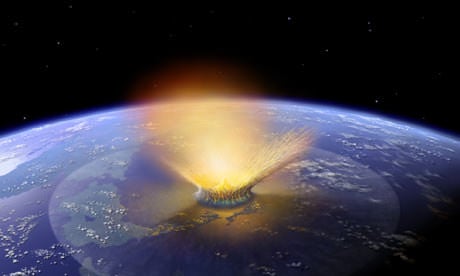For decades, scientists have debated the cause of the mass extinction that wiped out the dinosaurs and other life 65 million years ago. While the majority of researchers agree that a massive asteroid impact at Chicxulub, Mexico is the culprit, there have been some dissenters. Now, new research is questioning just a portion of the asteroid/Cretaceous-Paleogene extinction scenario. While the scientists involved in the study don't doubt that such an asteroid impact actually happened, their research shows it is just not possible that vast global firestorms could have ravaged our planet and be the main cause of the extinction.
Researchers from the University of Exeter, University of Edinburgh and Imperial College London recreated the vast energy released from a 15-km wide asteroid slamming into Earth, which occurred around the time that dinosaurs became extinct.
They found that close to the impact site -- a 180 km wide crater in Mexico -- the heat pulse would have lasted for less than a minute. This intense but short-lived heat, the team says, could not have ignited live plants, challenging the idea that the impact led to global firestorms.
However, they did find that the effects of the impact would actually be worse on the other side of the planet, where less intense but longer periods of heat could have ignited live plant matter.
"By combining computer simulations of the impact with methods from engineering we have been able to recreate the enormous heat of the impact in the laboratory," said Dr. Claire Belcher from the University of Exeter. "This has shown us that the heat was more likely to severely affect ecosystems a long distance away, such that forests in New Zealand would have had more chance of suffering major wildfires than forests in North America that were close to the impact. This flips our understanding of the effects of the impact on its head and means that palaeontologists may need to look for new clues from fossils found a long way from the impact to better understand the mass extinction event."
The Cretaceous-Paleogene extinction was one of the biggest in Earth's history and geologic evidence of the impact has been discovered in rock layers around the world from this time period. Some critics of the asteroid impact theory as a cause of the extinction have pointed to some of the microfossils from the Gulf of Mexico that show the impact occurred well before the extinction and could not have been its primary cause. Others point to volcanism that produced the Deccan traps of India around this time as a possible cause of the extinction.
But multiple models have showed such an impact would have instantly caused devastating shock waves, tsunamis, and the release of large amounts of dust, debris and gases that would have led to a low light levels and a prolonged cooling of Earth's surface. The darkness and a global winter would have decimated the planet life and the dependent animals.
So while fire and brimstone may not have played a big role in the Cretaceous-Paleogene extinction, there was plenty of destruction and mayhem for the resulting extinction of more than 70% of known species.
Here's a video from the researchers that shows their findings that close to the impact site, the heat pulse was too short to ignite live plant material.
Their research is published in the
Journal of the Geological Society
.
Source:
University Exeter
 Universe Today
Universe Today
